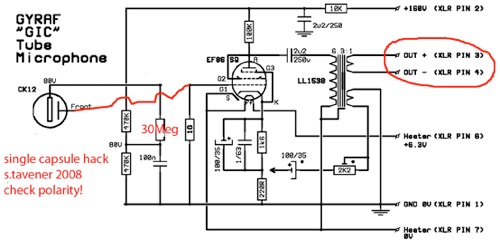Blue Jinn
Well-known member
Single sided G7 build. Schematic found here: (xaudia blog)

Mic started out as a MXL9000 which I got a sweet deal on. Didn't have the PSU, and then I "had" to take the capsule out for a (single sided) "BigUgly" so repurposed this one for a G7. I negligently damaged the AA Bv8 transformer I was going to use so I used a 3U Audio 6.5:1 transformer.
I also couldn't fit the 2u2 capacitors I have, so had to go with a 1uF I had on hand. Soviet 6Ж32П Tube. Capsule is Chinese originally from WGT, edge terminated C12sh clone. PSU is a Chinese zener regulated board from Ebay with a 150VAC toroid. I used the datasheet for a 78xx not the one on the board. I can only get 150VDC unloaded, but it seems to work OK.
I changed the voltage divider to 470k and 270k to get about 50v at the capsule. For some reason I couldn't find an axial 100uF/35 volt electrolytic for a decent price at Mouser, which is why that radial is shoehorned in there.
Total cost of the build will be well under ~US$250 give or take including everything else: the case for the PSU, cable, XLR plugs and sockets, etc. Mic body was only $20 though. On optest mic is nice and quiet, a little bright, sensitive even though I'm not the tidiest builder... Going to try it out soon! I don't know how "good" it is, but it was a fun build.




Mic started out as a MXL9000 which I got a sweet deal on. Didn't have the PSU, and then I "had" to take the capsule out for a (single sided) "BigUgly" so repurposed this one for a G7. I negligently damaged the AA Bv8 transformer I was going to use so I used a 3U Audio 6.5:1 transformer.
I also couldn't fit the 2u2 capacitors I have, so had to go with a 1uF I had on hand. Soviet 6Ж32П Tube. Capsule is Chinese originally from WGT, edge terminated C12sh clone. PSU is a Chinese zener regulated board from Ebay with a 150VAC toroid. I used the datasheet for a 78xx not the one on the board. I can only get 150VDC unloaded, but it seems to work OK.
I changed the voltage divider to 470k and 270k to get about 50v at the capsule. For some reason I couldn't find an axial 100uF/35 volt electrolytic for a decent price at Mouser, which is why that radial is shoehorned in there.
Total cost of the build will be well under ~US$250 give or take including everything else: the case for the PSU, cable, XLR plugs and sockets, etc. Mic body was only $20 though. On optest mic is nice and quiet, a little bright, sensitive even though I'm not the tidiest builder... Going to try it out soon! I don't know how "good" it is, but it was a fun build.


